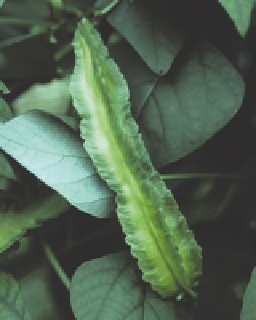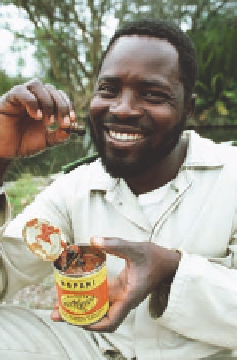Environmental Engineering Reference
In-Depth Information
10
Soil
Pest
Control
Food, Soil, and
Pest Management
Soil
Renewal
Food
Production
Biodiversity
CASE STUDY
Would You Eat Winged Beans
and Bug Cuisine?
Figure 10-2
Natural capital:
Emperor moth caterpillars, called
Mopani,
and a number of other in-
sects are used as a low-carbohy-
drate, low-fat, high-protein sources
of food in many parts of the world.
Most of the world's people live mainly on a diet of
wheat, rice, or corn—but these foods do not provide
enough protein so that they can avoid malnutrition.
Those who can afford it get protein by supplementing
these grains with various types of beans and meat
such as beef, chicken, pork, and fish.
The conventional approach to food production
presents two problems.
First,
most of the poor cannot
afford to eat meat.
Second,
modern agriculture has a
greater harmful environmental impact than any other
human activity.
Some analysts recommend greatly increased culti-
vation of less widely known plants to partially over-
come these problems. One possibility is the
winged
bean
(Figure 10-1), a fast-growing, protein-rich plant
found in New Guinea and Southeast Asia. Its edible
winged pods, spinach-like leaves, tendrils, and seeds
contain as much protein as soybeans. The seeds can be
ground into flour or used to make a caffeine-free bev-
erage that tastes like coffee.
This plant has so many different edible parts that
it has been called a
supermarket on a stalk.
It also needs
little fertilizer because of nitrogen-fixing nodules in its
roots—a trait that reduces the harmful environmental
effects of cultivating it as a source of food.
Some edible insects—called
microlivestock
—are
also important potential sources of protein, vitamins,
and minerals in many parts of the world. There are
about 1,500 edible insect species.
One example is
Mopani
(Figure 10-2)—emperor
moth caterpillars—one of
several insects eaten in
South Africa. This food is so
popular that the caterpillars
(known as mopane worms)
are being overharvested.
Kalahari desert dwellers eat
cockroaches, giant waterbugs
are crushed and used in veg-
etable dip in Thailand, lightly
toasted butterflies are a fa-
vorite food in Bali, black ant
larvae are served in tacos in
Mexico, and French-fried
ants are sold and eaten like peanuts on the streets of
Bogota, Colombia. Other examples are fried scorpions
in peanut sauce, giant waterbugs tucked inside corn
tamales, and a powder made from crickets and worms
that is used to flavor foods.
A few cooks and chefs are having “critter tasting”
parties. Numerous websites provide bug menus, bug
nutritional information, and phone numbers for dis-
tributors of edible bugs.
Most of these insects are low-carbohydrate, low-
fat sources of food and are 58-78% protein by weight—
three to four times the level found in protein-rich foods
such as beef, fish, chicken, or eggs. Consuming more of
these plentiful insects would help reduce malnutrition
and lessen the large environmental impact of produc-
ing conventional forms of meat.
Rapidly growing and reproducing edible bugs
could be produced in small “bug farms” with little or
no need for water, fertilizers, and pesticides. Indeed,
people could have a small container for producing
their favorite bugs in a garage, basement, or back yard.
Why don't we depend more on animals such as
protein-rich insects and plants such as the winged
bean? One problem is persuading farmers to assume
the financial risk of cultivating new types of food
crops. Another is convincing consumers to try new
foods. Would you eat a bug soup?
Athird problem is that seed companies and pro-
ducers of conventional sources of meat are not push-
ing these alternative food sources because even a
slight move toward adopting these sources of food
would sharply reduce their profits.
Figure 10-1
Natural capital:
the winged bean, a fast-growing,
protein-rich plant, could be
grown to help reduce malnutri-
tion and the harmful environmen-
tal effects from applying large
amounts of inorganic fertilizer.





